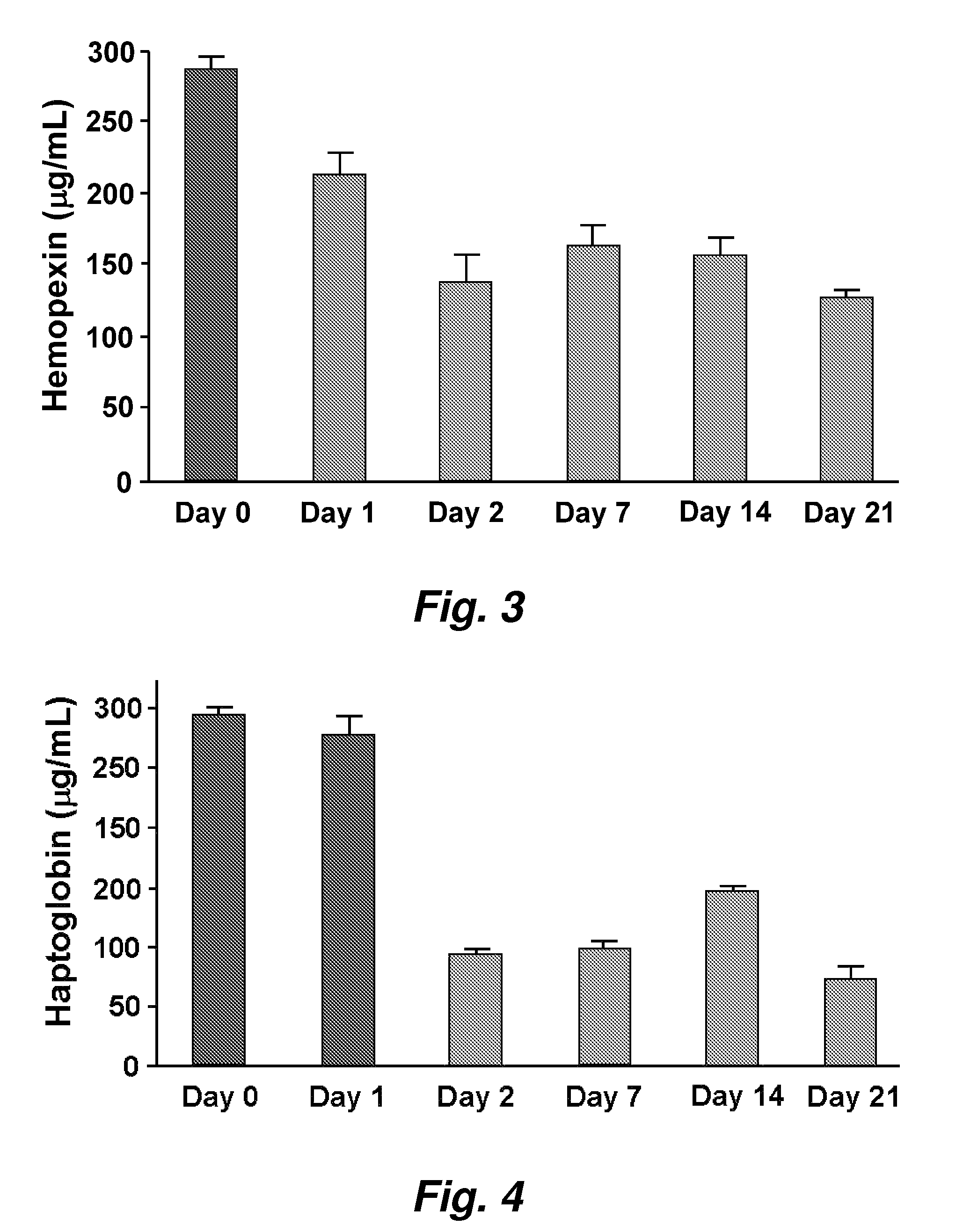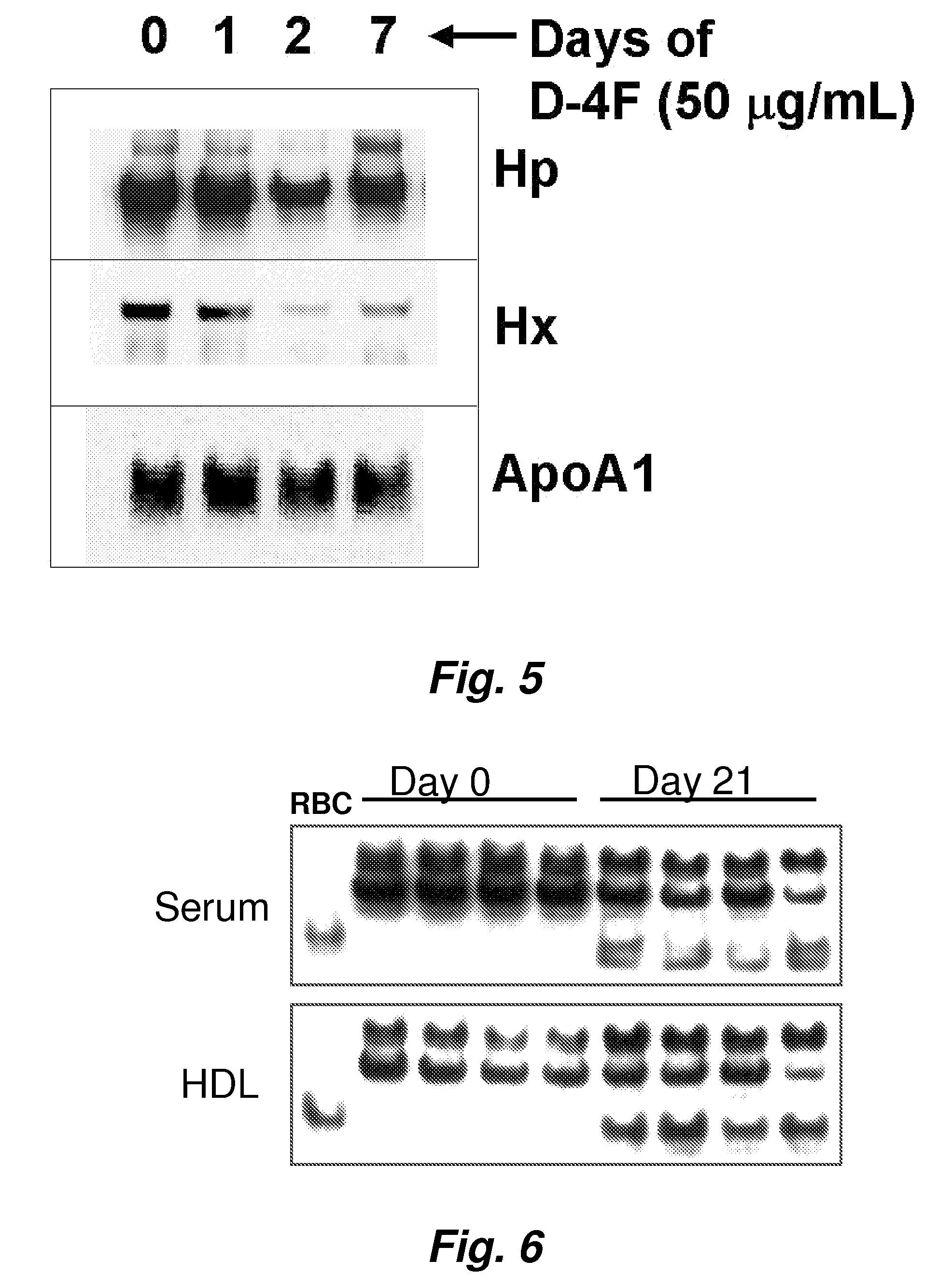Assays to predict atherosclerosis and dysfunctional high-density lipoprotein
a high-density lipoprotein and atherosclerosis technology, applied in the field of atherosclerosis diagnosis, can solve the problems of high cost, cumbersome and cumbersome current tests for dysfunctional hdl,
- Summary
- Abstract
- Description
- Claims
- Application Information
AI Technical Summary
Benefits of technology
Problems solved by technology
Method used
Image
Examples
example 1
Measurements of Hemoglobin, Haptoglobin and Hemopexin
[0156]The ELISA protocols for haptoglobin and for hemopexin are shown below as are the protocols for preparing HDL-supernatants and for apoA-I associated immunoabsorbed proteins.
Human Hemoglobin ELISA
[0157]
TABLE 1Materials for hemoglobin ELISA.CatalogMaterialsVendorNumber1HRP Conjugated Goat anti-HumanNovusab19362HemoglobinBiologicals2Plate reader (e.g. VersaMax Tunable)MolecularDevices3Round bottom 96 well plate,Fisherpolypropylene, non-sterile4Immulon platesNunc12-565-5025TMBFisherF25-034-036H2SO4FisherNote:Bring all reagents to room temperature before use.
[0158]HDL Isolation with Magnetic Bead Reagent
[0159]1. Separate plasma or serum from blood sample using green top tube or serum separator tube and centrifuging @ 5° C. @ 2300 rpm for 20 minutes.
[0160]2. Remove supernatant (serum or plasma). Note: If sample is already frozen, thaw the sample and spin in centrifuge @ room temp. @ 12,000 rpm for 5 minutes. This should bring down ...
example 2
Protein Profiles in Pro-Inflammatory HDL
[0392]We have reported that the inflammatory properties of HDL are a more sensitive indicator of atherosclerosis than HDL-cholesterol levels, in both mice and humans. In this example, we describe the identification of specific protein fingerprints that distinguish normal mouse HDL from mouse HDL on atherogenic diets, using ProteinChip technology coupled with surface-enhanced laser desorption / ionization time-of-flight mass spectrometry (SELDI-TOF-MS). Feeding C57BL / 6J mice an atherogenic diet for one week resulted in lower HDL-cholesterol levels, reduced paraoxonase activity, increased reactive oxygen species content and reduced ability of the HDL to promote cholesterol efflux from macrophages. When the mice were switched back to a chow diet for an additional 2 weeks, the pro-atherogenic characteristics of HDL reverted to the normal phenotype. We identified a total of 88 SELDI peaks with p<0.05 to be differentially present in pro-inflammatory H...
example 3
Hemoglobin Associated with High Density Lipoproteins in Sera from Mice Fed Atherogenic / Hyperlipidemic Diets
[0438]In Example 2, we identified eight specific protein fingerprints using strong anion exchange SELDI ProteinChip technology that distinguish normal / anti-inflammatory HDL from pro-inflammatory HDL in mouse models of atherosclerosis. Using micro-liquid chromatography-tandem mass spectrometry, we identified the SELDI peaks representing m / z 14,900 and m / z 15,600, as mouse hemoglobin alpha chain (Hb-Alpha, 14.9 kDa) and mouse hemoglobin beta chain (Hb-beta, 15.9 kDa), respectively. Western blot analysis confirmed the differential association of Hb with pro-inflammatory HDL when compared to normal HDL. Biochemical characterization of Hb associated with HDL further showed that the Hb associated with pro-inflammatory HDL possess distinct physical and chemical properties including reduced pI (pI 4.0 & pI 7.0 vs. pI 7.5 or higher for free Hb), and association with high molecular weigh...
PUM
| Property | Measurement | Unit |
|---|---|---|
| temperatures | aaaaa | aaaaa |
| total volume | aaaaa | aaaaa |
| concentration | aaaaa | aaaaa |
Abstract
Description
Claims
Application Information
 Login to View More
Login to View More - R&D
- Intellectual Property
- Life Sciences
- Materials
- Tech Scout
- Unparalleled Data Quality
- Higher Quality Content
- 60% Fewer Hallucinations
Browse by: Latest US Patents, China's latest patents, Technical Efficacy Thesaurus, Application Domain, Technology Topic, Popular Technical Reports.
© 2025 PatSnap. All rights reserved.Legal|Privacy policy|Modern Slavery Act Transparency Statement|Sitemap|About US| Contact US: help@patsnap.com



